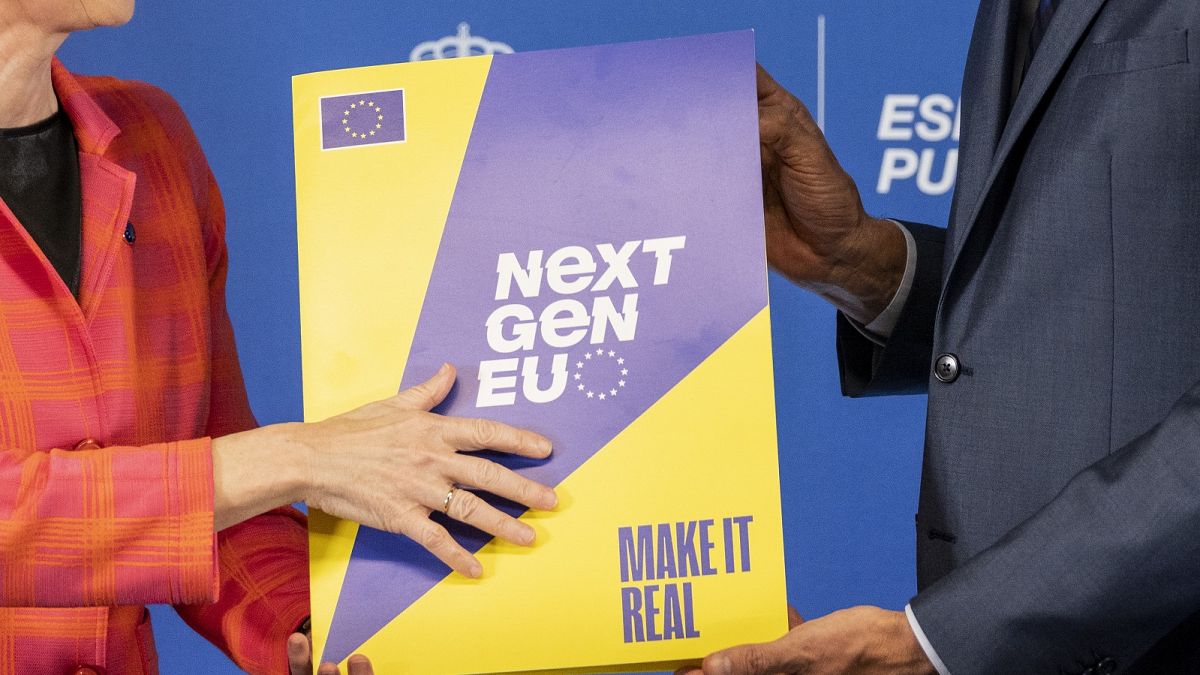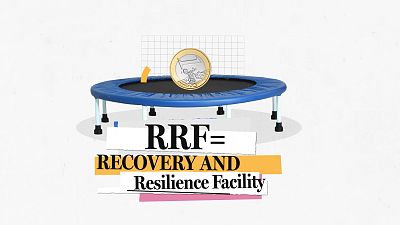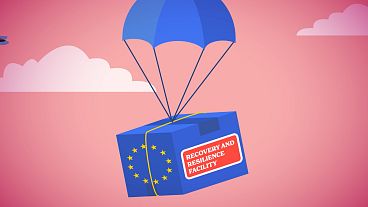The Recovery and Resilience Facility (RRF) is the biggest EU investment in history, but money from the post-Covid recovery fund is not flowing into the economy as expected.
The facility was seen as a historic step forward for EU economic solidarity, allowing the European Commission to issue joint debt on behalf of member states to revive a pandemic-ridden economy with green and digital investments.
Yet as the halfway mark approaches — payments are to be spread between 2021 and 2026 — just €153.38 billion (21.1%) of the €723.8 billion available to member states in loans and grants have been disbursed.
Bureaucratic bottlenecks, shifting political priorities and high inflation have been cited as reasons for unforeseen changes to the EU’s post-pandemic ambitions.
But experts disagree on whether diversions in the spending plan is a lost opportunity or simply good economic sense.
A challenging timeline
“It’s mathematical. It’s scientific. Some projects won’t be completed by 2026,” said Italy’s European Affairs Minister Raffaele Fitto in March. Italy has been allocated the biggest tranche of the funds at €191.5 billion, equal to 10.79% of its GDP.
While all member states’ spending plans have been endorsed by the Commission, eight are yet to receive payments, including Hungary and Poland whose funds are blocked amid rows with Brussels over democratic reforms.
Momentum in paying out funds has stalled, despite Commission chief Ursula von der Leyen recently urging countries to “get the money on the ground”. Only €53 billion were disbursed over the past year, compared to more than €100 billion in the previous 12 months.
For some, the lag in payments is natural as countries need breathing space to ensure the money is well spent.
"Spending money is hard. Doing reforms is hard. Doing reforms to qualify for spending money on a fixed clock is really hard. So it is impressive that they are making as much progress as they are," Erik Jones, Director at the Robert Schuman Centre for Advanced Studies told Euronews.
“When plans were agreed in 2020, everyone feared a deep and lasting recession and wanted to get the money out of the door quickly,” according to Daniel Gros, Board Member at the Centre for European Policy Studies (CEPS).
“But in the end, the recession was short-lived. It's better for everybody that we take time to breathe and reassess spending priorities as circumstances change,” he added.
Last week, credit rating agency S&P Global pointed to corruption oversight, EU state aid rules and high inflation as possible reasons for delays, concluding that Spain - whose €69.5 billion allocation is the second-biggest -and Italy might need extra time.
"The money has to be out the door by the end of 2026. This calendar cannot be shifted. So everyone is working as fast as they can, but the bandwidth simply isn’t there in many cases," said Jones.
Accumulating too much spending at the last minute could create volatility on the financial markets. While there is officially no flexibility on the 2026 deadline for investments, sources familiar with the issue have revealed discussions on a possible extension are ongoing.
A new experiment
The RRF is the first example of performance-based funding, where countries must hit so-called ‘milestones and targets’, including legislative reforms and green investments, to access funds. The most recent data reveals only 11% of milestones and targets have so far been fulfilled across member states.
Experts believe progress in hitting targets will naturally be slower as payments advance.
“In 2021 and 2022, the speed of disbursements was fast and in line with the planned timeline. We are now entering a more challenging phase where countries must deliver investments,” said Francesco Corti, a research fellow at CEPS.
Last Thursday, Italy managed to unlock a third payment of €18.5 billion after a months-long duel with Brussels over its targets. Rome’s creative attempts to demonstrate an investment in urban forestation by counting the seeds it had procured, rather than the trees planted, were rejected by Brussels.
Both Italy and Spain have allocated a significant portion of funds to constructing new nurseries and primary schools. With public procurement processes requiring months to approve, and construction costs high due to inflation and supply chain disruptions, hitting these investment targets quickly is proving challenging.
“Investments are facing the double challenge of rising inflation and disrupted supply chains. It is reasonable that member states ask for more flexibility or to modify their plans,” said Corti.
Tracing the money 'complicated'
Furthermore, understanding to which projects the money flows is complicated, according to Monika Hohlmeier, Chair of the European Parliament’s Budgetary Control Committee. “We want to know how much money has reached the real economy […] We want to see the real figures,” she said in May.
The Commission has committed to publishing the biggest 100 beneficiaries of funds in each member state. But the information available is patchy, with the data currently missing for 16 countries.
“We should strive for greater transparency in spending so that NGOs and journalists can also stand guard over EU taxpayers' money,” Krzysztof Izdebski of Open Spending EU Coalition said, “without data, it is difficult for them to perform such a role.”
“We have also checked whether countries themselves want to spend the funds transparently. The results are mixed - for example, Lithuania and Bulgaria are doing great, but Slovenia and Romania are reluctant to share this information. We need a more unified approach,” he added.
The gaps in reporting raise legitimate questions about possible fraud and corruption. The European Court of Auditors (ECA) found "room for improvement” in the Commission's anti-fraud measures. "The EU executive did not plan to examine how the countries check that RRF-funded investment projects comply with EU and national rules," a spokesperson said.
“The compliance of the funded projects with such rules is in a way self-policed by the member states,” the spokesperson added, “this is why we warned that this new spending model faces an assurance and accountability gap.”
An unforeseen energy crisis
Countries were recently asked to add so-called ‘REPower EU chapters’ to their recovery plans to fund projects aimed at reducing dependency on Russian energy and accelerating the green transition, with a total of €225 billion available for investments.
Eni, Enel and other state-controlled Italian energy groups are due to benefit from a partial transfer of the RRF funds to the REPower EU scheme, credit rating agency DBRS revealed this week.
According to NGO Climate Action Network (CAN) Europe, this has made a potential €67 billion available for fossil fuel projects, including liquefied natural gas (LNG) and, in the case of Hungary, Czechia and Slovakia, oil infrastructure.
“We can expect a significant number of LNG and pipeline projects to be included in respective REpower EU chapters,” Olivier Vardakoulias of CAN Europe said.
“This amendment to the RRF regulation constitutes a serious backtracking in the process of progressively excluding fossil fuel projects from the eligibility of EU funds,” he added.
Some experts believe the channelling of funds to more energy projects is necessary.
“The world has changed in a way that could not have been foreseen. We need a second line of energy resources as an insurance policy. We’re better safe than sorry,” said Daniel Gros.
So far, 17 member states have modified their plans, most recently Austria and Belgium. Some countries, such as Czechia, have already been commended for removing controversial investments in oil and gas pipelines from their recovery plans.



